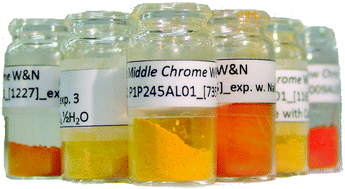Chrome yellow in nineteenth century art: historic reconstructions of an artists' pigment†
Abstract
To understand the reported degradation of chrome yellows, popular with artists since their introduction in the 19th century, it is necessary to understand the pigment formulation as produced at that time. Chromium-based pigments such as lead chromate (PbCrO4, chrome yellow) or zinc chromate (K2O·4ZnCrO4·3H2O, zinc yellow), as used by Van Gogh and Seurat, currently exhibit substantial darkening in paintings such as “Sunflowers” or “A Sunday on La Grande Jatte-1884”. Winsor & Newton (W&N), one of the leading artists' colourmen of the time, has made its recipe archive available. Access to their extensive chrome yellow pigment formulations prompted our research on the stability of these pigments by reconstructing their processes of manufacture. The colorants obtained were compared with contemporary tube paints from W&N as well as with samples from paintings by Amadeo de Souza-Cardoso (1887–1918) an influential modernist Portuguese painter. Good correlation between all three sources was found.


 Please wait while we load your content...
Please wait while we load your content...